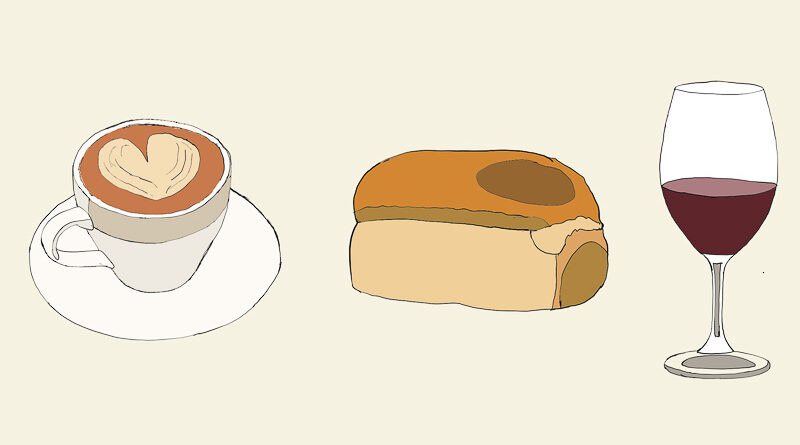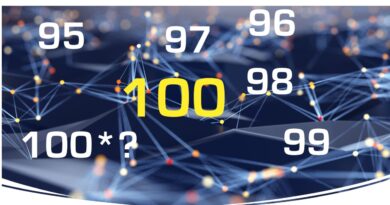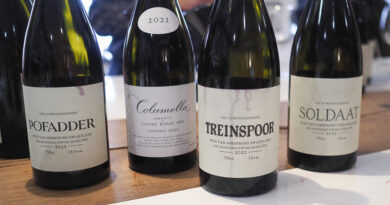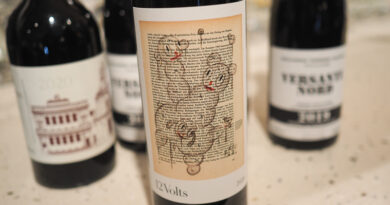Learning to recognize wine: on objects and perception, part 2
When we experience a smell, it is almost never a single molecule that we are smelling. We recognize mixtures of molecules and are able to lump them together as a single smell (for example, coffee, bread, cheese, exhaust fumes, rose petals) even against the background of other odors.
This is quite remarkable. Consider a bustling street market, with lots of food stalls. There are so many odorants (molecules that have a smell) in the air, but still we can identify specific smells. How do we know which odor molecules go together? They are all present in the air, but we are able instinctively to group them together into sets, which together make up single smells.
This is because our brain has learned to identify patterns of smells. As we sniff, unconsciously we are scanning the smell space for patterns. Then, if enough boxes are ticked, we recognize a particular odor ‘object’. This was discussed in part 1 of this article. Here, I’m going to explore how scientists have tried to reconstruct these odor objects synthetically. [As I discussed in part 1, it’s possible to go further than just considering odor: we can involve other senses and think of flavor, or even further and consider all the properties: a sensory object.]
There’s obviously a lot of interest in being able to synthesize food and drink aroma, and part of this is commercial, part experimental. So understanding the chemical basis of different odor objects has been the subject of many studies. How many different molecules do you need to make up the smell of bread? Is there a minimum set that will work? Rather than looking for just one or two key aroma molecules, why not look for this interacting set?
For wine, it would be interesting to be able to recreate some of the world’s great wines. These are often fiendishly rare and expensive, and if you could make a copy that experts would be fooled by, then this could be of great interest. Imagine what a learning tool this would be! [A separate question is whether we would derive anything like the pleasure from a facsimile DRC that cost just $10 than we would from the real thing, even if we couldn’t tell the two apart.]
But it would also be interesting to be able to make a model wine for experimental purposes. This has already been done, although it’s not starting from scratch: it involves deodorizing a base wine and then adding back the most important aromatics. This approach allows the effect of aroma compounds to be tested in context, and also in different combinations.
The big breakthrough that promised to unlock the secrets of odor molecules in food and drink was the emergence of the gas chromatograph (GC). Debuting in the 1960s, this analytical technique began identifying a large number of aroma molecules. It’s currently thought that there are around 10 000 different odorants found in food.
But despite this powerful experimental apparatus, early experiments that aimed to reconstitute olive oil and orange juice failed. Some of the important aromas are present at very low levels, and they were being missed. It was time to re-do the experiments, and research shifted to a sensomic approach, looking at everything that is there, rather than being reductionistic, and looking at different odorants in isolation.
The existing technology was good at identifying all the molecules that were there, and which could then be described in terms of their smells. But it was unable to look at the interactions among odorants, which are key when it comes to the actual smell of foods and drinks. The perception of mixtures of odorants is not a sum of the perception of the individual compounds.
This is because mixtures of more than four odorants gain a new single odor quality: the individual components lose their distinctive smells. This has been shown in experiments where people can’t identify more than four odorants in a mix.
But this is the interesting thing: while we can’t discriminate the individual odorants in a mixture, we can discriminate mixtures from each other: we can separate odor objects.
One example of components losing their individuality is when (2)-1,5-octadien-3-one (which smells of geranium) is combined with 3-(methylthio)propanal (also known as methional, which smells of cooked potato, at a ratio of 1:100. The individual smells are lost and the mixture smells fishy. Alone they smell totally different.
But it’s not just any combination of odors that creates new smells. If you combine more than 30 volatiles, there are two conditions where this creates what has been called ‘olfactory white’. The first is when these odors span a wide part of the olfactory space, and the second is where the individual odorants are present at equal intensity. This raises the question: how are the odor objects of foods and drinks different from olfactory white? The answer lies in their particular combinations: ones we have come to recognise as odor objects.
These odor objects are formed and modulated in the piriform cortex of the brain. And various studies have shown that synthetic blends of a limited number of odor compounds can be recognizable as odor objects.
Thomas Hofmann is Professor of Food Chemistry and Molecular Sensory Science, at the Technische Universität in München, Germany. With his colleagues he has carried out a study that examines 119 different scientific publications that have examined what are referred to as ‘key food odorants’ (KFOs) in 227 different types of food and drink. These included alcoholic beverages, meat products, fish and sea food, bakery products, dairy products, fats, fruits, vegetables, mushrooms, spices, cocoa and chocolate and coffee.
The really interesting finding here? That you can define the odor object of most foods and drinks with around 230 different odorants, out of the 10 000 or so odorants that are present in these foods and drinks. So just 230 KFOs can define the odor stimulus space of gastronomy! This includes wine.
Hofmann and his colleagues then went on to unpack this further. Looking at the individual olfactory stimuli, they examined their impact. This is reached by looking at the ratio between the concentration they are present at, and the threshold for detection by our noses and palates (the odor activity value, OAV). For example, one study looked at a red Dornfelder wine. It found that the aroma of this wine could be accounted for by 28 KFOs, and then these were recombined in their natural concentrations in an experimental wine. This ranged from 0.9 µg/litre for the cooked apple-like smelling beta-damascenone, 79 040 µg/litre for the flowery smelling 2-phenylethanol and 641 900 µg/l for acetic acid. These three molecules have odor detection thresholds of 0.01, 18 and 5600 µg/litre, respectively, so they are demonstrating OAVs of 90, 4391 and 115.
They also examined this group of 230 odors and split them into three groups. There are 16 generalists, found in more than a quarter of samples. Then there are 57 intermediaries, found in 5-25% of samples. And then there are 151 individualists, which are present in fewer than 5% of foods and drinks: these are often highly distinctive. An example would be diallyl disulfide in garlic. These are often found at very low levels and are important: if you skip them, the synthetic odor is unconvincing.
Using a technique called hierarchical cluster analysis, Hofmann and colleagues split up all these different aroma signatures. Cluster 1 is tea, fruit, spices, seafood. Cluster 2 is split in four: (a) alcoholic beverages; (b) dairy; (c, d) meat, vegetables, fat, bakery and others. This seems to be more relevant than previous, mostly unsuccessful attempts to categorize smells and define the odor space, because it is a data driven approach.
The significance of this work? It’s unpicking the important information that we use to recognize collections of odorants as specific, identifiable smells. We need to learn which combinations of odors create the objects that we need to recognize in order to navigate the world around us. Just as the cartoonist’s pen can, with a few lines, produce something we recognize as a car, or a tree, or as a person with a particular emotional state, a particular collection of relatively few smells can represent a particular olfactory object. This work unpicks the lines of the cartoonist’s pen, as it were.
But it is unlikey that all our olfactory performance is about learning ‘objects’. There are likely two elements to olfaction. To reduce it simply to a learning process that enables objects to be discriminated doesn’t provide a fully adequate explanation of how our sense of smell works. There is also likely some hardwired communication going on. Any response to smells on the part of an infant is evidently hard wired, not learned. Also, any response we have to smells at subthreshold level (where we respond to odors at levels below which we can experience them consciously) is also likely not learned. So odor object learning is an important part of our olfactory system operation, but it doesn’t account for all of it.
For wine, the implications of this work are several. Chief among them is that it explains why attempts to break down the components of wine in our tasting notes is so difficult, even with the help of aroma wheels and the WSET standardized approach to tasting. Attempts to link the experience of wine to individual molecules are also problematic. It’s because we don’t actually perceive wine that way. We recognize combinations of molecules.




